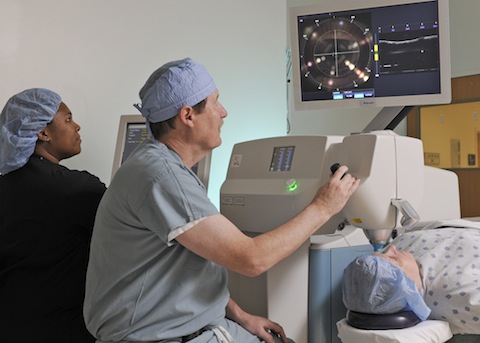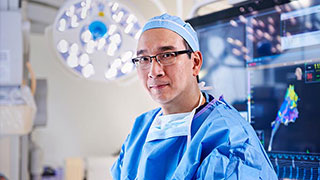What are Cataracts?
A normal part of aging, cataracts are a common eye condition in people 65 and older, but they can occur at any age. Cataracts occur when the normally clear lens of the eye becomes cloudy, affecting vision. A cataract can develop in one or both eyes, but it cannot spread from one eye to the other. Watch a video that provides an overview about cataracts.
Expertise in Treating Cataracts
Ophthalmologists at UT Southwestern Medical Center perform hundreds of outpatient cataract surgeries each year. This high volume translates to extensive experience and successful outcomes for our patients.
UT Southwestern’s physicians and researchers have access to the latest scientific findings and treatments for cataracts, such as blade-free, image-guided, laser-assisted cataract surgery, a procedure that we customize for each patient’s eyes.
Types of Cataracts
Although 90 percent of cataracts occur in elderly people, there are other types of cataracts, such as:
- Congenital cataracts, when babies are born with the condition
- Secondary cataracts, which can develop in people who have had surgery for other eye conditions, have other health problems such as diabetes, or take corticosteroids
- Traumatic cataracts, which develop from an eye injury
- Radiation cataracts, which are caused by exposure to certain types of radiation
Possible Risk Factors and Causes of Cataracts
These risk factors can cause cataracts to develop earlier:
- Extensive exposure to ultraviolet light (such as sunlight), which can be prevented with sunglasses that block ultraviolet-B (UVB) light
- Trauma to the eyes
- Certain chronic conditions such as diabetes
- Medications such as corticosteroids
- Smoking
- Poor nutrition
Cataract Symptoms
Cataracts tend to develop slowly, with gradual worsening of vision. Symptoms include:
- Cloudy or blurry vision
- Colors that seem faded
- Glare or halo around headlights, sunlight, or other bright lights
- Double or multiple vision
- Poor night vision
- Frequent prescription changes in eyeglasses or contact lenses
Diagnosing Cataracts
Other eye conditions can also cause these symptoms. To detect a cataract and rule out other conditions, UT Southwestern ophthalmologists perform a comprehensive medical eye exam.
We evaluate the health of our patients’ eyes through tests such as:
- Vision test
- Dilated eye test to allow the physician to examine structures inside the eye
- Tonometry, a painless test that measures pressure inside the eye
Treatment Options for Cataracts
For patients with early-stage cataracts, a change in the strength of their prescription (glasses, bifocals, or contact lenses) or the use of a magnifying lens can improve vision.
Cataract surgery is needed only when vision loss interferes with patients’ everyday work or leisure activities. The results of cataract surgery are usually the same whether a person waits months or years. Patients have time to carefully consider the treatment options before proceeding with surgery.
Types of Cataract Surgery
Surgery involves removing the cloudy lens and replacing it with an artificial one. At UT Southwestern, our experienced ophthalmologists offer two techniques for cataract surgery: laser and traditional. In traditional cataract surgery, the surgeon uses micro instruments to perform the procedure.
UT Southwestern Ophthalmology is the first practice in Dallas to offer blade-free, image-guided, laser-assisted cataract surgery. In this procedure, the physician uses computerized laser equipment to perform the incision and other critical stages of the surgery.
Laser-assisted cataract surgery offers potential benefits over traditional surgery, such as:
- Greater accuracy in making the incision and inserting the replacement lens
- Simpler removal of the cloudy lens (the cataract)
- Faster recovery
Not all patients are good candidates for laser-assisted cataract surgery. Our ophthalmologists will discuss which treatment options are best suited for each individual patient.
Any surgical procedure carries a certain risk of complications. Patients should be sure to discuss with their doctors all aspects of the procedure to weigh the risks and benefits of cataract surgery.
Intraocular Lens Replacement Options
Following the removal of the cataract, the surgeon will implant an artificial intraocular lens (IOL). There are many lens options available, and no lens is perfect for everyone. Our physicians will help patients choose the best lens based on extensive preoperative testing and discussion with the patient’s about his or her goals for the surgery.
Some patients find that they no longer need glasses or contact lenses after cataract surgery with replacement multifocal IOLs in both eyes. Our ophthalmologists will discuss all options with each patient.
Slowing Cataract Formation
Although there is no way to prevent cataracts, research has shown ways to slow down the onset of the condition:
- Schedule regular eye exams, especially for those who have chronic health conditions like diabetes and thyroid disease that can increase the risk of developing cataracts.
- Wear sunglasses or a hat to shield the eyes from the sun and its ultraviolet light.
- Wear protective eyewear to avoid possible injury when working with dangerous machinery or chemicals or playing sports.
- Stop smoking.
- Eat a balanced diet with plenty of fruits, vegetables, and fish, which have vitamins and minerals that might slow aging of the eyes.









